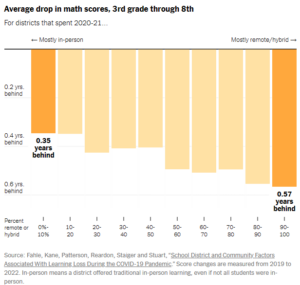If you haven’t yet read our widely publicized COVID Lessons Learned study that we released last week, you can access it here. One of the most vital lessons learned was that school closures were a disaster for our kids.
So we were pleased to see that the New York Times now – finally – admits this:
Today, there is broad acknowledgment among many public health and education experts that extended school closures did not significantly stop the spread of Covid, while the academic harms for children have been large and long-lasting…
“Closing schools did not appear to significantly slow Covid’s spread… “Infectious disease leaders have generally agreed that school closures were not an important strategy in stemming the spread of Covid,” said Dr. Jeanne Noble, who directed the Covid response at the U.C.S.F. Parnassus emergency department.
And they presented this chart, a version of which is also in our COVID Lessons Learned paper:
Of course, unlike the New York Times, we opposed school closures from the beginning – and actively countered false reporting by the Times and others who went all out to keep kids locked out of schools.
The one thing conspicuously missing from the Times article is accountability for the paper’s leading role in this disaster:

New York Times COVID reporter Apoorva Mandavilli deserves special mention here for contributing most of the paper’s fake news reporting about kids and COVID. This includes the time she told the world’s foremost pediatric COVID expert that honesty about the about-the-same-as-flu risk to children was “supremely unhelpful”:


